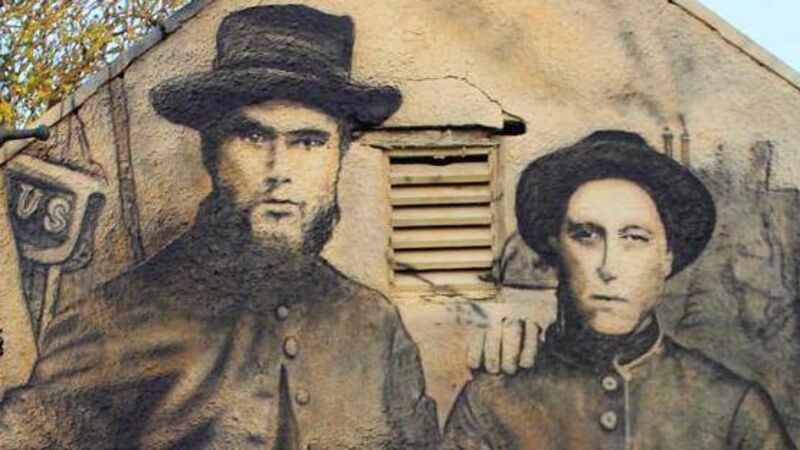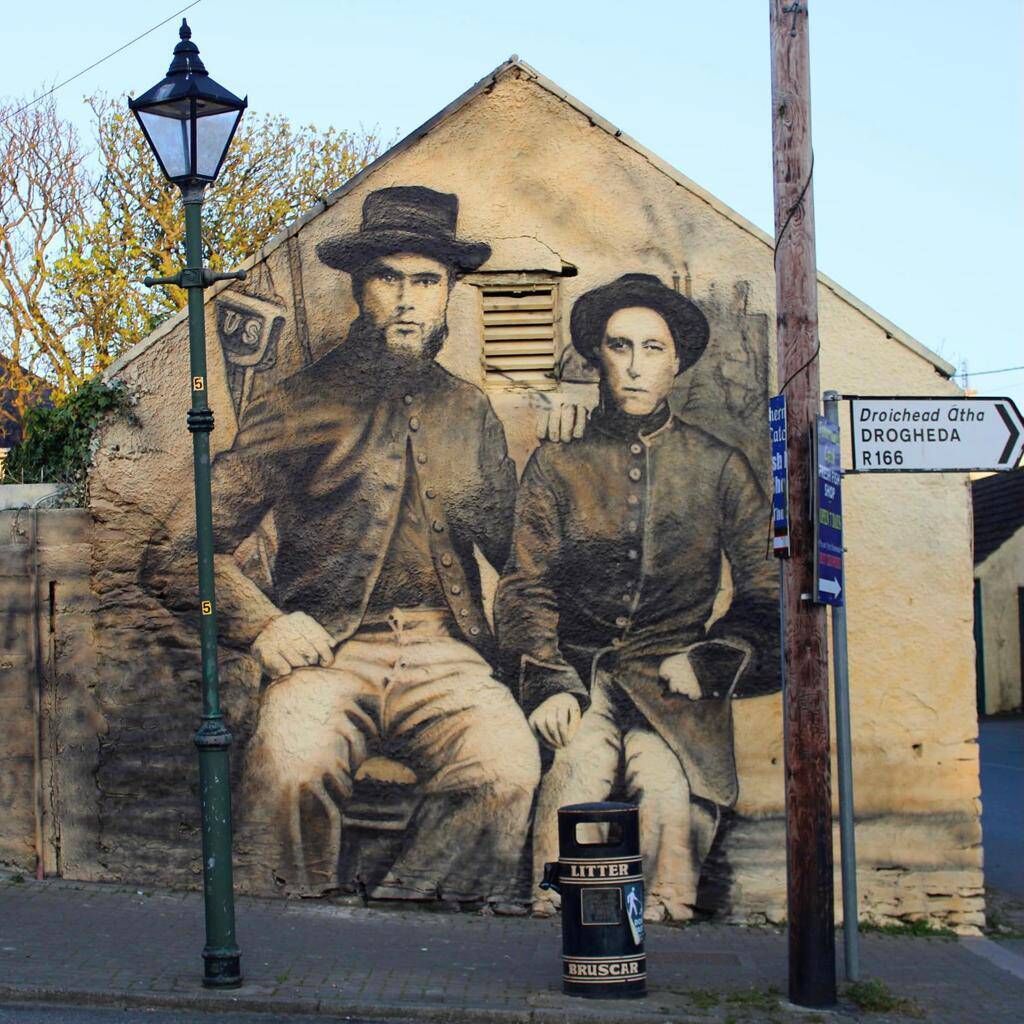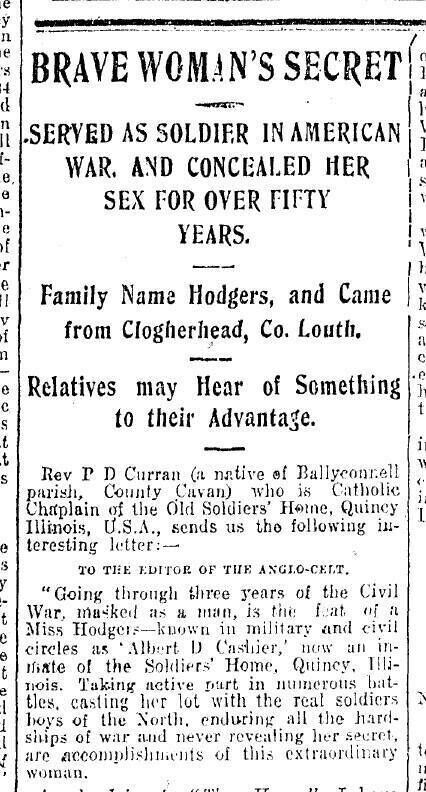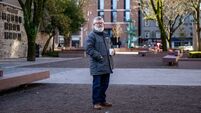Clodagh Finn: We could all learn a lot from the astonishing story of Albert Cashier

The mural by Ciarán Dunlevy commemorates Albert Cashier from Clogherhead Co Louth who fought in the American Civil War. Picture: Ciarán Dunlevy
The story of Albert Cashier of Clogherhead in Co Louth is a story for our times, for so many reasons. A spectacular mural showing him in uniform alongside a fellow soldier reminds us that some 200,000 Irish people fought in the American Civil War.
It’s not as if we need reminding but war, like death and taxes, is ever present.
The other striking thing about this stunning piece of street art by Ciarán Dunlevy is that it was unveiled on March 31, International Transgender Day of Visibility. That was a happy coincidence, but it could not have been more apt because Albert Cashier started life as Jennie Hodgers in the fishing village of Clogherhead where she was born on Christmas Day in 1843 to Denis and Catherine Hodgers.
Her mother died when she was “still very young”, according to her brother Patrick, and her father and aunt left her to the boat in Drogheda en route to America when she was a teenager.
At some point, possibly on board, she decided to dress as a boy/man. Perhaps Albert Cashier, as he became, realised that there were limited options for an illiterate female immigrant in 19th-century America.
He worked initially in a shoe store, according to some accounts.
And then, aged 19, he saw an opportunity and enlisted in the Union Army in Company G, 95th Illinois Infantry in August 1862.
The new recruit, military records noted, was five-foot three, had auburn hair and blue eyes. It wasn’t surprising that Albert could pass as a man. Medical examinations were so crude that it was said army policy was not to test eyes, but simply to count them.
Albert Cashier went on to distinguish himself over the next three years, during which he saw action in some 40 battles. His sergeant commended him when he scrambled up a tree to reattach the company flag that had been taken down by enemy fire during the Battle of Vicksburg. He was even said to have taunted retreating Confederate soldiers in the process.
Later, when he was captured while out on reconnaissance, he grabbed a gun from his captors, knocked down the guard and ran back to his camp.
He was honourably discharged in 1865 and continued to live as a man, getting a variety of jobs in Illinois; farm worker, janitor, plant nursery assistant, church caretaker, to mention a few.
In 1910, however, his biological sex was revealed when he was ill and his neighbour, Mrs PH Lannon, sent her nurse to assist him. The nurse apparently ran home and said: “My Lord, Mrs Lannon, he’s a full-fledged woman.”
They said nothing, though, and when Albert’s sex was again apparent after a car accident and he was admitted to a veteran’s home, he was given private quarters “out of respect”.
When the Civil War Pension Board got wind of the story, however, they accused Albert Cashier of fraud, maintaining that the frail woman now in a retirement home could not possibly have fought in America's civil war. What happened next is remarkable. His former army colleagues came to his defence.

It puts us to shame to see that a group of soldiers in the early 20th century could look past their shock — they were said to be stunned by the revelation — and stand up for their former comrade. The board relented and paid Albert his pension.
The word ‘transgender’ did not exist then, but the Irish chaplain to Albert’s Old Soldier’s Home in Quincy, the Revd Fr PD Curran from Cavan, showed more understanding in 1913 than is often seen today.
In a letter to the editor of The Anglo-Celt in 1913, he wrote: “[Albert] wanted to be a man, and because Nature cheated her of this privilege she did the next best thing, disguised as a man, so she could do a man’s work, lead a man’s life and be a man in everything, but sex.”
We can’t say if Albert would identify as transgender today but, for a large part of his life, he lived happily as a man. When his identity was revealed, he was allowed to continue to do so, for a time at least. That ended in 1914, when he developed dementia and was admitted to the women’s ward of Watertown State hospital and forced to wear a skirt.
When his former comrade Charles W Ives, of Company G, visited him, he was distressed by what he found: “I left Cashier, the fearless boy of 22, at the end of the Vicksburg campaign. When I went to Watertown [hospital], I found… a frail woman of 70, broken, because, on discovery, she was compelled to put on skirts. They told me she was as awkward as could be in them. One day she tripped and fell, hurting her hip. She never recovered.”

When Albert Cashier died in 1915, aged 71, he — and the pronoun is important here — was given full military honours. Six decades later, the community in Saunemin, Illinois, inserted Albert’s Irish identity on his gravestone, adding: “Jennie Hodgers, the girl who emigrated to the United States”.
He is celebrated in the US and has been the subject of musicals and documentaries there.
At home, Fiona Ní Eidhin’s excellent documentary, [Jennie Hodgers — Lincoln’s Soldier], was aired on TG4 in 2017.
Now, in a sense, Albert Cashier has returned home thanks to the unveiling of Ciarán Dunlevy’s mural in his hometown. Fittingly enough, that did not come without a battle. A local community group, Visit Clogherhead, fought for two years to get permission to paint it.
They might still be waiting had the group not gone directly to the community, who funded the cost of the mural through GoFundMe. The project went ahead, in the end, because a private individual gave permission to allow his gable wall to be used as a canvas.
As well as being an arresting piece of street art, it is also a reminder that LGBTQI+ has a long history. At a time in Ireland when homophobia is rearing its ignorant, violent, ugly head again, it could not be more relevant.
As artist and pioneer of Irish street art Ciarán Dunlevy says: “I’ve witnessed too many friends and family being discriminated against because of race, gender, and sexuality.
He says it was an absolute honour to create this tribute to one of Ireland’s many great emigrants.
“I see this story and life as a powerful act of resistance to the injustices of the time. It is inspiring to see the people in Jennie/Albert’s hometown giving them the recognition they deserve. We need more stories like this brought from the shadows into the light in this country.”
We really do. And making those stories visible on the streets of our towns is one powerful way of reminding us that there is so much to learn from the past.











